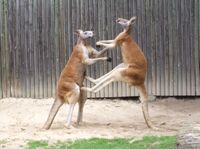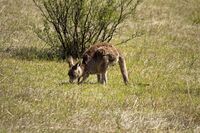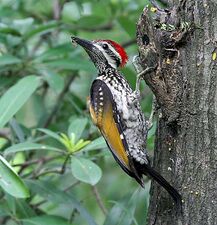Biology:Tripod stance


A tripod stance is a behaviour in which quadruped animals rear up on their hind legs and use their tail to support this position. Several animals use this behaviour to improve observation or surveillance, and during feeding, grooming, thermoregulation, or fighting.[1]
In mammals
The common dwarf mongoose (Helogale parvula) adopts a tripod stance when being vigilant for predators.[2] In a similar mammal, the thirteen-lined ground squirrel (Spermophilus tridecemlineatus), vigilance behaviour includes four postures: (1) quadrupedal alert (all four feet on the ground with head above the horizontal); (2) semiupright alert (on hind feet with a distinctive slouch); (3) upright alert (on hind feet with back straight and mostly perpendicular to the ground); (4) extended upright alert (similar to upright alert except that the squirrel extends its hind legs,[3] (see image of meerkats). In meerkats (Suricata suricatta), the tripod stance may be adopted relatively briefly during foraging, in which case it is termed guarding behaviour, or for substantially longer periods when the animal is not foraging, in which case it is termed sentinel behaviour.[4]
Macropods can stand erect on their hind legs, supported by their tail as the third leg of the tripod.[5] Macropods also engage in "pentapedal locomotion," an energy-inefficient gait used at slow speed,[6] in which "the tail is used, with the forelimbs, as the third leg of a tripod to support the animal while the large hind limbs are moved forward."[7]
Giant armadillos (Priodontes maximus) have a well-developed sense of smell but poor eyesight. When approached by a potential threat, they rise up onto their hind legs, supported by the tail and begin to sniff from side to side. This tripod stance is similar to the defensive position adopted by anteaters and enables them to strike out with their sharply-hooked claws if suddenly attacked.[8]
It has been reported that the desert woodrat (Neotoma lepida) gives birth "...in a bipedal position supported by the tail."[9]
In reptiles and amphibians
Monitor lizards such as the Komodo dragon (Varanus komodoensis) quite commonly stand on a tripod formed by their hind legs and tail.[10][11]
Spectacled salamanders (Salamandrina terdigitata) sometimes stand on their hind legs supported by their tail. This reveals their brightly coloured belly, but the behaviour (referred to as "stand up behaviour") is performed in the absence of other salamanders or predators, and its function is unknown.[12]
Some dinosaurs may also have occasionally adopted a tripod stance.[13]
Similar behaviour in non-quadrupeds
Several non-quadrupeds adopt a tripod-like stance and may have specialised structures to achieve this.
The tripodfish (Bathypterois grallator) has long, bony rays that protrude below its tail fin and both pectoral fins. Although the body of the fish is 36 cm (14 in), its fins can be more than 1 m (3 ft 3 in). The tripod fish spends much of its time standing on its three fins on the bottom of the ocean, hunting its food.[14]
All woodpeckers have "zygodactyl" feet - two toes in front, two behind - as an aid in clinging to tree bark. In addition, stiff modified tail feathers on most species help to prop the bird in a tripod stance when clinging vertically.[citation needed]
Many leaf-mining moths adopt a tripod stance when resting on a surface.[15]
- Tripod-like stance in non-quadrupeds
Tripod fish in its usual stance
See also
References
- ↑ Hickman, Graham C. (December 1979). "The mammalian tail: a review of functions". Mammal Review (Wiley) 9 (4): 143–157. doi:10.1111/j.1365-2907.1979.tb00252.x.
- ↑ Apps, Peter (2000). Creatures of Habit: Understanding African Animal Behaviour. Struik. p. 117. ISBN 1770073922. https://books.google.com/books?id=39dl4pXv1kYC&pg=PA117.
- ↑ Arenz, C.L.; Leger, D.W. (2000). "Antipredator vigilance of juvenile and adult thirteen-lined ground squirrels and the role of nutritional need". Animal Behaviour 59 (3): 535–541. doi:10.1006/anbe.1999.1345. PMID 10715175. https://digitalcommons.unl.edu/psychfacpub/480.
- ↑ Townsend, S.W., Zöttl, M. and Manser, M.B. (2011). "All clear? Meerkats attend to contextual information in close calls to coordinate vigilance.". Behavioral Ecology and Sociobiology 65 (10): 1927–1934. doi:10.1007/s00265-011-1202-6. https://www.zora.uzh.ch/id/eprint/54306/2/Townsend_et_al_All_Clear.pdf.
- ↑ Hume, Ian D. (1982). Digestive Physiology and Nutrition of Marsupials. Cambridge University Press. p. 117. ISBN 0521238927. https://books.google.com/books?id=f6U8AAAAIAAJ&pg=PA117.
- ↑ Kear, Benjamin P.; Lee, Michael S. Y.; Gerdtz, Wayne R.; Flannery, Timothy F. (2008). "Evolution of Hind Limb Proportions in Kangaroos (Marsupialia: Macropodoidea)". in Sargis, Eric J.; Dagosto, Marian. Mammalian Evolutionary Morphology. Springer. pp. 25–35. ISBN 978-1-4020-6996-3.
- ↑ Hume, I.D.; Jarman, P.J.; Renfree, M.B.; Temple-Smith, P.D. (1987). "29. MACROPODIDAE". Fauna of Australia. Australian Bureau of Flora and Fauna. ISBN 9780644054836. http://www.environment.gov.au/system/files/pages/a117ced5-9a94-4586-afdb-1f333618e1e3/files/29-ind.pdf.
- ↑ Smith, P. (2007). FAUNA Paraguay Online Handbook of Paraguayan Fauna Mammal Species, Account 6 Priodontes maximus.. http://www.faunaparaguay.com/primaxhb.html.
- ↑ Bleich, V.C.; Schwartz, O.A. (1975). "Parturition in the White-Throated Woodrat". The Southwestern Naturalist 20 (2): 271–272. doi:10.2307/3670445.
- ↑ Auffenberg, Walter (1981). The Behavioral Ecology of the Komodo Monitor. University Press of Florida. p. 134. ISBN 081300621X. https://books.google.com/books?id=MirXwMe94JgC&pg=PA134.
- ↑ Frauca, Harry (1982). What animal is that?: a guide to Australian amphibians, insects, mammals, reptiles, and spiders. Doubleday. p. 154. ISBN 0868240745.
- ↑ Utzeri, C., Antonelli, D. and Angelini, C. (2005). "Notes on the behavior of the Spectacled Salamander". Herpetozoa 18 (3–4): 182–185. http://www.landesmuseum.at/pdf_frei_remote/HER_18_3_4_0182-0185.pdf.
- ↑ Martin, Anthony J. (2009). Introduction to the Study of Dinosaurs (2nd ed.). Wiley. p. 434. ISBN 978-1444309119. https://books.google.com/books?id=yyw54rNbX1kC&pg=PA434.
- ↑ Jones, AT; KJ Sulak (1990). "First Central Pacific Plate and Hawaiian Record of the Deep-sea Tripod Fish Bathypterois grallator (Pisces: Chlorophthalmidae)". Pacific Science 44 (3): 254–7. http://scholarspace.manoa.hawaii.edu/bitstream/10125/1281/1/v44n3-254-257.pdf.
- ↑ Wilson, R.. "Bird and wildlife photography: Lepidoptera Gracillariidae". http://www.raywilsonbirdphotography.co.uk/Galleries/Invertebrates/Lepidoptera/Gracillaridae.html.
External links
- Image of an otter in a tripod stance
- Images of various rodent species in a tripod stance
- Image of a monitor lizard in a tripod stance
 |





